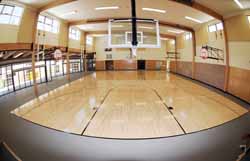Robbins Flooring Moved From Parquetry to Manufacturing NCAA Basketball Courts
Robbins Inc., with a plant in White Lake, traces its roots to the 1894 founding of the Cincinnati Floor Company by Robert A. Stoehr. Still headquartered in Cincinnati, the company originally designed and manufactured fine parquetry that replicated designs from English royalty and French chalets.
Through four generations and 120 years of operation, the business has grown and changed many times, having been involved in virtually all aspects of the residential, commercial, recreational and sports flooring business, from design, manufacture, and installation, to distribution, aftermarket floor care services.
Robbins currently focuses on two primary vertical markets, indoor sports/recreation and residential flooring.
“By staying focused on the needs of our customers and remaining true to our core values and core purpose, Robbins has grown and become known as an innovator and a trusted partner,” John Williams, vice president of manufacturing, said.
“Delivering on this passion has led to more than 25 patents over the years with additional patents pending,” Williams added. “In use every day, these innovations have improved flooring aesthetics for home owners and institutions, improved the ease and speed of installation for contractors, and have improved game play response, comfort and safety for users of all ages and skill level.”
Robbins owns a sawmill in Kenton, Mich. and manufactures a wide variety of unfinished and prefinished northern strip, plank and parquet flooring and sports flooring systems at plants in White Lake and Ishpeming, Mich. Robbins also distributes a full line of synthetic sports flooring systems and commercial flooring products.
Their success in high profile venues speaks for itself:
—80 percent of NBA teams currently own Robbins competition and/or training facility floors.
—More NBA teams compete and train on Robbins court than all other competitors combined.
—23 of the past 27 NBA champions played their home games on a Robbins’ court.
—13 of the 16 2014 NBA playoff teams compete and/or train on a Robbins’ court.
—In the past four years alone, almost 50 percent of the teams in the Men’s NCAA tournament played their home games on a Robbins’ court, including the past six champions.
—Past NCAA champs include Louisville, UConn, Duke, North Carolina, Indiana, Kentucky, Michigan and the list goes on and on and on.
The employee needs and the specific skill sets required by those employees are anticipated to change over the next 10 years. This is being driven by the fact that customers today and in the future continue to want more choices and options available to them with shorter lead times at competitive prices.
“In order to service our customers at the levels they expect we need to be able to have an organization and manufacturing facility that is more capable and flexible in making that happen,” Williams said.
That flexibility begins with developing an organization of employees that culturally supports and has the mind set of continuously improving processes and procedures to achieve these goals, Williams explained. With the advances in technology it means ongoing investment in training and education for existing employees and a willingness for those employees to learn new skill sets and leverage the technology that is now available. The information made available today through current operating systems was not available 10 or 20 years ago.
“Having employees with the abilities to utilize these systems to their fullest results in improved materials management, more consistent and higher quality products, more efficient scheduling, improved on time delivery, lower costs, and ultimately higher customer satisfaction,” Williams said. “Over the next 10 years a much broader base of employees will need to have more specialized training in and a good working knowledge of such things as Lean/Six Sigma, SPC, Preventive Maintenance, and Quick change over to name a few in order to stay competitive in the marketplace.”
The type of training required varies depending on the position. Some positions may require an industry recognized certification while others may require internal or external training.
Internal training is often accomplished by the individual learning and becoming familiar with specific written grading rules and specifications in conjunction with mentored training sessions and audits while running actual material.
“In order to maintain consistency in training we utilize designated trainers within our organization that have demonstrated the skills and ability necessary to properly educate and train new employees,” Williams said.
Outside vendors are also used in training employees on processes and procedures that might be specific to their product or equipment.
Industry-specialized workshops and training seminars, as well as community-based education classes through colleges, universities, and technical schools are also utilized.
Manufacturing Spotlight is a limited-term series that looks at some of the industries located in the Antigo area with an eye on letting potential employees understand the opportunities that exist in the region and the skills required. It is being done in cooperation with the Langlade County Economic Development Corporation and Northcentral Technical College. Comments and suggestions are always invited and can be sent to adjlisa@solarus.net.
Source: Antigo Daily Journal

